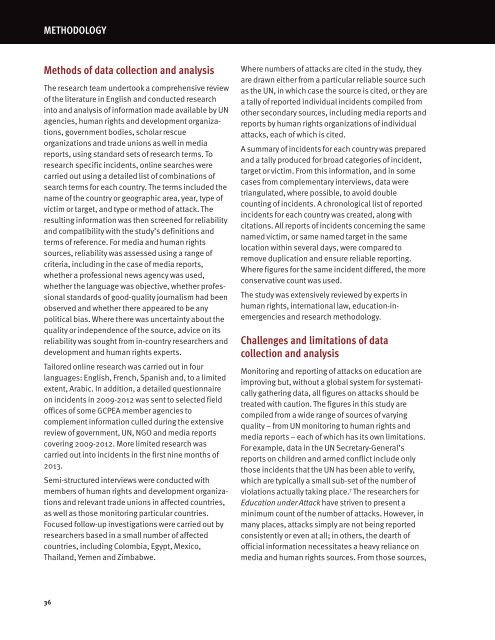eua_2014_full.pdf?utm_content=buffer4a392&utm_medium=social&utm_source=twitter
eua_2014_full.pdf?utm_content=buffer4a392&utm_medium=social&utm_source=twitter
eua_2014_full.pdf?utm_content=buffer4a392&utm_medium=social&utm_source=twitter
- No tags were found...
You also want an ePaper? Increase the reach of your titles
YUMPU automatically turns print PDFs into web optimized ePapers that Google loves.
MeTHODOLOGYMethods of data collection and analysisThe research team undertook a comprehensive reviewof the literature in English and conducted researchinto and analysis of information made available by UNagencies, human rights and development organizations,government bodies, scholar rescueorganizations and trade unions as well in mediareports, using standard sets of research terms. Toresearch specific incidents, online searches werecarried out using a detailed list of combinations ofsearch terms for each country. The terms included thename of the country or geographic area, year, type ofvictim or target, and type or method of attack. Theresulting information was then screened for reliabilityand compatibility with the study’s definitions andterms of reference. For media and human rightssources, reliability was assessed using a range ofcriteria, including in the case of media reports,whether a professional news agency was used,whether the language was objective, whether professionalstandards of good-quality journalism had beenobserved and whether there appeared to be anypolitical bias. Where there was uncertainty about thequality or independence of the source, advice on itsreliability was sought from in-country researchers anddevelopment and human rights experts.Tailored online research was carried out in fourlanguages: English, French, Spanish and, to a limitedextent, Arabic. In addition, a detailed questionnaireon incidents in 2009-2012 was sent to selected fieldoffices of some GCPEA member agencies tocomplement information culled during the extensivereview of government, UN, NGO and media reportscovering 2009-2012. More limited research wascarried out into incidents in the first nine months of2013.Semi-structured interviews were conducted withmembers of human rights and development organizationsand relevant trade unions in affected countries,as well as those monitoring particular countries.Focused follow-up investigations were carried out byresearchers based in a small number of affectedcountries, including Colombia, Egypt, Mexico,Thailand, Yemen and Zimbabwe.Where numbers of attacks are cited in the study, theyare drawn either from a particular reliable source suchas the UN, in which case the source is cited, or they area tally of reported individual incidents compiled fromother secondary sources, including media reports andreports by human rights organizations of individualattacks, each of which is cited.A summary of incidents for each country was preparedand a tally produced for broad categories of incident,target or victim. From this information, and in somecases from complementary interviews, data weretriangulated, where possible, to avoid doublecounting of incidents. A chronological list of reportedincidents for each country was created, along withcitations. All reports of incidents concerning the samenamed victim, or same named target in the samelocation within several days, were compared toremove duplication and ensure reliable reporting.Where figures for the same incident differed, the moreconservative count was used.The study was extensively reviewed by experts inhuman rights, international law, education-inemergenciesand research methodology.Challenges and limitations of datacollection and analysisMonitoring and reporting of attacks on education areimproving but, without a global system for systematicallygathering data, all figures on attacks should betreated with caution. The figures in this study arecompiled from a wide range of sources of varyingquality – from UN monitoring to human rights andmedia reports – each of which has its own limitations.For example, data in the UN Secretary-General’sreports on children and armed conflict include onlythose incidents that the UN has been able to verify,which are typically a small sub-set of the number ofviolations actually taking place. 7 The researchers forEducation under Attack have striven to present aminimum count of the number of attacks. However, inmany places, attacks simply are not being reportedconsistently or even at all; in others, the dearth ofofficial information necessitates a heavy reliance onmedia and human rights sources. From those sources,36


